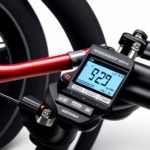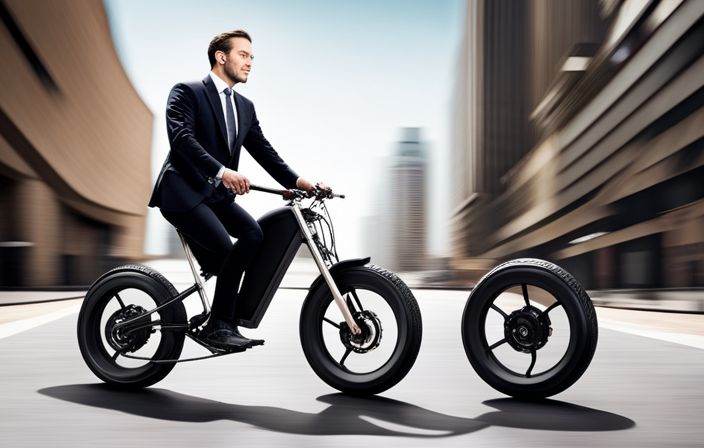Tired of pedaling your electric bike and need a battery replacement? Look no further!
In this informative guide, I will walk you through the steps to replace your electric bike battery, ensuring a smooth and hassle-free process.
From assessing the condition of your current battery to properly disposing of the old one, we’ve got you covered.
So, grab your tools and let’s get started on upgrading your ride to optimal performance!
Key Takeaways
- Regularly charging the electric bike battery is important for maintaining capacity and performance.
- Proper disposal of old batteries is necessary to ensure environmental safety.
- If the battery is not charging, check the charger connection and inspect for damages or loose connections.
- If the battery life is short, remove power-consuming accessories and if the issue persists, consider replacing the battery.
Assessing the Condition of Your Current Battery
You’ll want to start by checking the condition of your current battery. Evaluating battery life and determining battery capacity are crucial steps in replacing an electric bike battery.
First, inspect the physical condition of the battery. Look for any signs of damage such as cracks, leaks, or bulges.
Next, test the battery’s voltage using a multimeter. Compare the reading to the manufacturer’s specifications to determine if it is still within the acceptable range.
Additionally, assess the battery’s overall performance. Pay attention to how long it holds a charge and if it provides sufficient power for your rides. If you notice a significant decrease in battery life or capacity, it may be time to replace it.
Properly evaluating the condition of your current battery will help you make an informed decision when replacing it.
Researching and Purchasing a Replacement Battery
When researching and buying a new battery, it’s important to consider the specifications and compatibility with your electric bike. Here are some key factors to keep in mind:
-
Battery lifespan and maintenance: Look for a battery that has a long lifespan and requires minimal maintenance. This will ensure that you can enjoy your electric bike for years to come without any hassle.
-
Different types of electric bike batteries and their pros and cons: There are various types of electric bike batteries available, such as lithium-ion, lead-acid, and nickel-metal hydride. Each type has its own advantages and disadvantages, so it’s crucial to understand them before making a decision.
-
Lithium-ion batteries: These are the most common and offer a good balance of weight, capacity, and lifespan. They are lightweight and have a high energy density, making them ideal for electric bikes.
-
Lead-acid batteries: These are the cheapest option but are heavy and have a shorter lifespan. They require regular maintenance and can be less efficient.
Consider these factors when researching and purchasing a replacement battery for your electric bike.
Gathering the Necessary Tools for the Replacement
To gather the necessary tools for the replacement, make sure you have a set of basic hand tools such as screwdrivers, pliers, and wrenches. These tools will enable you to easily access and remove the old battery from your electric bike.
When choosing the right replacement battery, it is crucial to consider the specifications of your e-bike model. Look for a battery that matches the voltage and capacity requirements.
Additionally, proper maintenance of your e-bike battery is essential for its longevity and performance. Regularly inspect the battery for any signs of damage or wear, and clean the contacts to ensure a good connection. It is also important to charge the battery properly, following the manufacturer’s instructions.
By taking these steps, you can ensure that your replacement battery functions optimally and lasts for a long time.
Disconnecting the Old Battery from Your Electric Bike
First, make sure you have the necessary tools for the job. To disconnect the old battery from your electric bike, you will need a set of wrenches or an Allen key, depending on the type of bolts holding the battery in place.
Begin by turning off the power to your electric bike and locating the battery compartment. Carefully remove any screws or bolts securing the battery cover and set them aside.
Next, identify the connectors that attach the battery to the bike’s electrical system. Using the appropriate tool, gently loosen and disconnect these connectors. Be sure to handle the connectors carefully to avoid damaging them.
Once all the connectors are disconnected, carefully lift the battery out of the compartment, taking care not to strain any wires or cables.
With the battery removed, you can now proceed to the next step of the replacement process.
Installing the New Battery onto Your Electric Bike
Now it’s time to attach the new battery onto your e-bike. Here are some important steps to follow for a successful installation:
-
Check battery compatibility: Ensure that the new battery is compatible with your electric bike model. Refer to the manufacturer’s guidelines or consult an expert if unsure.
-
Disconnect power: Before installing the new battery, make sure the power to your electric bike is turned off. This will prevent any electrical surges or accidents during the installation process.
-
Remove old battery: Carefully detach the old battery from its mounting location. Be mindful of any connectors or wires that may be attached and remove them gently.
-
Install new battery: Position the new battery in the same mounting location as the old one. Secure it firmly in place using the provided screws or brackets. Reconnect any connectors or wires, ensuring a snug fit.
By following these installing techniques and ensuring battery compatibility, you can successfully attach the new battery to your electric bike.
Making Sure the Battery is Properly Connected
Once you have attached the new battery, make sure to double-check that all the connections are properly secured. This step is crucial to ensure the smooth functioning and longevity of your electric bike’s battery.
Start by checking the battery voltage using a multimeter to ensure it is within the recommended range. This will help you identify any potential issues with the battery’s charge.
Additionally, it is important to ensure proper battery maintenance. Keep the battery clean and free from dirt or moisture, as this can affect its performance. Regularly inspect the battery for any signs of damage or wear, such as cracks or leaks.
By following these steps and taking proper care of your electric bike’s battery, you can maximize its lifespan and enjoy a hassle-free riding experience.
Testing the New Battery for Functionality
To ensure your new battery is functioning properly, you should test it for functionality. There are several testing methods you can use to determine if the battery is working as expected.
One way is to connect the battery to the charger and observe if it charges fully within the specified time.
Another method is to connect the battery to the electric bike and check if it provides sufficient power for the bike to run smoothly.
Additionally, you can use a multimeter to measure the voltage and current output of the battery to ensure they are within the specified range.
It’s important to note that the battery lifespan can vary depending on factors such as usage patterns and maintenance. Regular testing and monitoring of the battery’s functionality will help you identify any issues and ensure optimal performance.
Charging Your New Battery for Optimal Performance
Charging your new battery will help ensure optimal performance. To optimize battery performance and extend its lifespan, it is crucial to follow the recommended charging guidelines. Here are some key points to keep in mind:
| Charging Tips | Explanation |
|---|---|
| Use the provided charger | Using the charger specifically designed for your electric bike battery will ensure proper voltage and current levels, preventing any potential damage. |
| Charge in a cool environment | Heat can deteriorate battery performance and shorten its lifespan. Charging in a cool environment will help maintain the battery’s optimal temperature. |
| Avoid overcharging | Overcharging can lead to battery degradation. It is essential to monitor the charging process and disconnect the battery once it reaches its full charge. |
| Regularly charge your battery | It is recommended to charge your battery after each ride, even if it is not fully discharged. Regular charging helps maintain the battery’s capacity and overall performance. |
By following these charging tips, you can optimize your battery’s performance and extend its lifespan, ensuring you get the most out of your electric bike experience.
Properly Disposing of the Old Battery
Make sure you properly dispose of your old battery to ensure environmental safety and compliance with local regulations. Proper battery disposal is crucial to prevent harm to the environment and human health.
When it comes to recycling old batteries, there are a few important steps to follow. Firstly, you should never throw your old battery in the regular trash. Instead, check with your local recycling center or electronic waste collection facility to see if they accept batteries for recycling. Many of these places have specific guidelines for battery disposal, so it’s important to follow their instructions.
Some manufacturers or retailers may also offer battery recycling programs, so it’s worth checking with them as well. Remember, by recycling your old battery, you are contributing to a cleaner and safer environment.
Troubleshooting Common Issues during the Replacement Process
During the replacement process, it’s important to troubleshoot common issues that may arise. Here are four common battery problems and troubleshooting techniques to resolve them:
-
Battery not charging:
- Check the charger connection and ensure it is securely plugged into the power source and the battery.
- Inspect the charger for any damages or loose connections.
- If the charger appears to be working fine, the issue may lie with the battery itself, and it might need replacement.
-
Short battery life:
- Determine if the battery is being drained by any power-consuming accessories.
- Remove any unnecessary devices and test the battery’s performance.
- If the issue persists, the battery could be nearing the end of its lifespan and may require replacement.
-
Battery overheating:
- Overheating can be caused by excessive use or a faulty battery.
- Allow the battery to cool down and check for any visible signs of damage.
- If the problem continues, consult a professional technician to assess and potentially replace the battery.
-
Battery not fitting properly:
- Ensure the replacement battery is compatible with your electric bike model.
- Check for any physical obstructions preventing the battery from fitting securely.
- If necessary, consult the manufacturer’s guidelines or seek assistance from a professional to ensure a proper fit.
Remember, troubleshooting battery issues during the replacement process is crucial to ensure the efficient operation of your electric bike.
Frequently Asked Questions
What is the average lifespan of an electric bike battery?
The average lifespan of an electric bike battery is influenced by various factors. These include usage patterns, charging habits, temperature conditions, and the quality of the battery itself. It typically ranges from 2 to 5 years.
Can I use a different brand of battery as a replacement for my electric bike?
Yes, you can use a different brand of battery as a replacement for your electric bike. However, it’s important to consider compatibility concerns to ensure the battery is suitable for your bike’s specifications and electrical system.
How do I know if my electric bike battery needs to be replaced?
To determine if an electric bike battery needs replacement, check its health by observing signs like reduced mileage, decreased power, longer charging times, or battery swelling. These indicators suggest a failing battery that may require replacement.
Are there any safety precautions I should take when replacing an electric bike battery?
When replacing an electric bike battery, it is important to follow safety precautions. Before starting the battery replacement process, make sure to disconnect the power source, wear protective gear, and handle the battery carefully to avoid any accidents or injuries.
Can I upgrade to a higher capacity battery for my electric bike?
Yes, upgrading to a higher capacity battery for an electric bike offers several benefits. It provides longer range, increased power output, and improved performance. However, compatibility with the bike’s existing electrical system should be considered before making the upgrade.
Conclusion
In conclusion, replacing the battery on my electric bike was quite the adventure.
I carefully assessed the condition of my old battery and did thorough research to find the perfect replacement.
Armed with the necessary tools, I disconnected the old battery and installed the new one with ease.
After testing its functionality, I charged the new battery for optimal performance.
Finally, I responsibly disposed of the old battery.
Throughout this process, I encountered a few hiccups, but with patience and perseverance, I overcame them.
This battery replacement journey was truly electrifying!
















